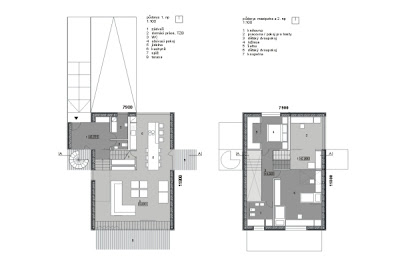Wooden House - Ondrej and Josef Chybik
Czech architects Ondrej and Josef Chybik have won a competition to design a low-energy timber house.
Winning proposal of the Wooden House Competition tries to restore a relation between house and context under condition of mass building production. The project accepts same principles as amateur creators of rural architecture, respecting weather and local specifications.
Conception
Despite the assumption of competition, the building is set into proper environment of Czech highland area, where harvesting and treatment of wood follows the inhabitants for centuries. Relation to local highland village archetype occurs in scale and form of the house, which represents a fusion between old and modern architecture. This is visible namely in the proportion of roof, orientation against Sun and solution of windows.
Spatial concept brings together not only a living hall, kitchen and dinning place, but also a study and children bedroom. Partly directly, partly visually through glass openings. Particular inner spaces are precisely fitting independent volume units, put into each other like a jigsaw. This results into one non-conflicting sum of outer mass. The only parts stepping out of this macrostructure are foyer and lee, signalizing an entrance. A staircase leads a visitor right into the living hall, illuminated through a gallery of second floor. Living space is optically extended by a glass wall facing the garden. Subsequent kitchen and dinner place have standard height, but they are directly connected with exterior terrace. The study, master bedroom and children room are located in upper floors.
Construction
The object is raised up from terrain. This creates an air pillow, insulating the house from earth humidity, melting snow or potential flooded spring.
Glued five layered platform, supported in points, forms a base of the construction. Vertical supports are made of doubled planks joined into leader (Vierendel) columns. Horizontal beams are stretched between them and the whole construction is stabilized by OSB boards. OSB boards serve also as steam-stoppers.
Wooden-aluminum windows will be glazed with insulation triple-glass. Interior is protected against Sun by outer jalousie. Perimeter walls and roof will be treated with mineral wool. Due to optimized perimeter constructions, respecting of cardinal points and following disposition and technical rules (for example – a complex system of heating, ventilating and water boiling should be installed), average annual energy consumption approaches passive standards.
Winning proposal of the Wooden House Competition tries to restore a relation between house and context under condition of mass building production. The project accepts same principles as amateur creators of rural architecture, respecting weather and local specifications.
Conception
Despite the assumption of competition, the building is set into proper environment of Czech highland area, where harvesting and treatment of wood follows the inhabitants for centuries. Relation to local highland village archetype occurs in scale and form of the house, which represents a fusion between old and modern architecture. This is visible namely in the proportion of roof, orientation against Sun and solution of windows.
Spatial concept brings together not only a living hall, kitchen and dinning place, but also a study and children bedroom. Partly directly, partly visually through glass openings. Particular inner spaces are precisely fitting independent volume units, put into each other like a jigsaw. This results into one non-conflicting sum of outer mass. The only parts stepping out of this macrostructure are foyer and lee, signalizing an entrance. A staircase leads a visitor right into the living hall, illuminated through a gallery of second floor. Living space is optically extended by a glass wall facing the garden. Subsequent kitchen and dinner place have standard height, but they are directly connected with exterior terrace. The study, master bedroom and children room are located in upper floors.
Construction
The object is raised up from terrain. This creates an air pillow, insulating the house from earth humidity, melting snow or potential flooded spring.
Glued five layered platform, supported in points, forms a base of the construction. Vertical supports are made of doubled planks joined into leader (Vierendel) columns. Horizontal beams are stretched between them and the whole construction is stabilized by OSB boards. OSB boards serve also as steam-stoppers.
Wooden-aluminum windows will be glazed with insulation triple-glass. Interior is protected against Sun by outer jalousie. Perimeter walls and roof will be treated with mineral wool. Due to optimized perimeter constructions, respecting of cardinal points and following disposition and technical rules (for example – a complex system of heating, ventilating and water boiling should be installed), average annual energy consumption approaches passive standards.
















Post a Comment